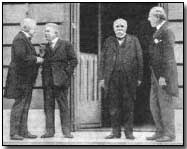Primary Documents - Treaty of Versailles, 28 June 1919
 This section of the website
details the full contents of the Peace Treaty of Versailles, signed on 28
June 1919 by Germany and the Allied powers at the Palace of Versailles.
A sizeable document, the treaty featured some 440 Articles, with the
addition of numerous Annexes.
This section of the website
details the full contents of the Peace Treaty of Versailles, signed on 28
June 1919 by Germany and the Allied powers at the Palace of Versailles.
A sizeable document, the treaty featured some 440 Articles, with the
addition of numerous Annexes.
Begun in early 1919 and completed in April after several months of hard bargaining, it was presented to Germany for consideration on 7 May 1919.
The German government was given three weeks to accept the terms of the treaty (which it had not seen prior to delivery). Its initial response was a lengthy list of complaints, most of which were simply ignored. The treaty was perceived by many as too great a departure from U.S. President Wilson's Fourteen Points; and by the British as too harsh in its treatment of Germany.
Controversial even today, it is often argued that the punitive terms of the treaty supported the rise of the Nazis and the Third Reich in 1930s Germany, which in turn led to the outbreak of World War II.
The Versailles treaty deprived Germany of around 13.5% of its 1914 territory (some seven million people) and all of its overseas possessions. Alsace-Lorraine was returned to France, and Belgium was enlarged in the east with the addition of the formerly German border areas of Eupen and Malmedy.
Among other territorial re-arrangements, an area of East Prussia was handed over to Lithuania, and the Sudetenland to Czechoslovakia.
The German army was limited to a maximum of 100,000 men, and a ban placed upon the use of heavy artillery, gas, tanks and aircraft. The German navy was similarly restricted to shipping under 10,000 tons, with a ban on submarines.
The contents of the treaty have been divided into fifteen sections, each of which deals with a particular aspect of the treaty. These can be accessed via the sidebar to the right.
| Description | Articles |
|---|---|
| The Covenant of the League of Nations | Articles 1-30 and Annex |
| Political Clauses for Europe | Articles 31-117 and Annexes |
| German Rights and Interests Outside Germany | Articles 118-158 and Annexes |
| Military, Naval and Air Clauses | Articles 159-213 |
| Prisoners of War and Graves | Articles 214-226 |
| Penalties | Articles 227-230 |
| Reparations | Articles 231-247 and Annexes |
| Financial Clauses | Articles 248-263 |
| Economic Clauses | Articles 264-312 and Annexes |
| Aerial Navigation | Articles 313-320 |
| Ports, Waterways and Railways | Articles 321-386 |
| Labour | Articles 387-399 |
| Procedure | Articles 400-427 and Annex |
| Guarantees | Articles 428-433 |
| Miscellaneous Provisions | Articles 434-440 and Annex |
'White Star' was a German mixture of chlorine and phosgene gas, so-named on account of the identification marking painted on the delivery shell casing.
- Did you know?
